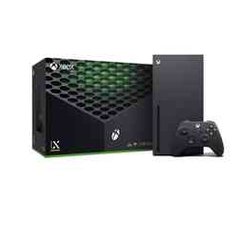The ULTRA HD standard has long been dominant in the TV market and is increasingly replacing devices with Full HD resolution and lower every year.
Manufacturers of large panels continue to improve their devices and are now competing for the wallets of gamers, promoting their products as gaming through the introduction of technologies inherent in gaming monitors. The creators of the latter are trying to keep up and are releasing new models that can compete with televisions not so much in panel sizes as in performance quality and gaming capabilities.
Such manufacturers include ASUS, which released the ROG Swift PG32UQ model this year. According to the company, this is the world's first 32-inch 4K monitor with HDMI 2.1 support, which is perfect not only for PCs, but also for current-generation consoles in the face of the Xbox Series X and PlayStation 5. It was he who entered our test laboratory and today we will tell you about him.
PACKAGING AND EQUIPMENT
The entire ROG Swift line comes in dark-colored packages made of thick cardboard with colorful printing, and the ROG Swift PG32UQ is no exception. On the front sides, the manufacturer has marked the images of the device on both sides, and on the ends you can find a lot of logos of various supported technologies and features that the product is equipped with.
Inside the ASUS ROG Swift PG32UQ is packed in two foam molds. The monitor is in a semi-assembled state. A leg stand and a plastic plug covering the compartment with connectors are already attached to the display. To place the monitor on the table, it is only necessary to attach a metal base to the rack, which can be done with a pair of built-in screws with convenient handles for tightening without a screwdriver or other tools.
The manufacturer placed all other small accessories in a small cardboard box. Inside it, we managed to find an HDMI cable marked 8K at the ends, a Display Port cable, a USB 3.0 Type B cable, four screws for hanging the monitor on the bracket, an external 180 watt power supply and a power cable, as well as a quick user manual, a set of stickers, a welcome card and a warranty card.
APPEARANCE AND CONNECTORS
The design of the PG32UQ differs little from the previous ROG Swift models tested by us over the past year, except for the dimensions and color execution of small details. The dimensions of the monitor assembly with a stand are 728 x 452 x 292 mm, and the weight is 9.7 kg with a stand and 6.1 kg without it.
In front, a large 32-inch screen is framed in a thin 1-1.5 mm thick frame on three sides. The lower part of the frame is, as always, the widest and slightly protruding from the screen. The traditional ROG logo is emblazoned on it. From below, closer to the right edge, you can notice the status LED, which glows white while using the device. It is not bright and does not distract at night, but if desired, it can be turned off in the settings.
The back side of the monitor is visually divided into two parts thanks to a glossy line running diagonally across the device with an indentation of several centimeters from the corners. One half is dotted with a texture with technical veins and a huge ROG logo with a glossy surface. Naturally, in accordance with the game orientation, the manufacturer could not help but add RGB backlight, and it is the logo that is its only part.
The backlight effect and colors can be adjusted via the on-screen menu of the monitor, as well as synchronized with other ASUS backlit devices thanks to AURA Sync support. The second half of the back wall is dotted with a texture of lines, and the only objects that stand out on this side are four control buttons and a 5-position joystick, which are used to control the monitor. On the right side, for clarity, the manufacturer indicated the designation signs for each button by default. However, when the menu is activated, they are also duplicated on the side of the device screen, so you are unlikely to pay attention to them when setting up.
By the standards of solutions with such a diagonal, the thickness of the monitor is quite normal. At the edges it is 20 mm, and by the middle of the dome-shaped body, under which the internal components are hidden, it increases to about 80 mm. Air circulation for cooling the internal components is carried out through the holes near the rack mounting, as well as at the upper and lower ends.
Two speakers of the monitor's built-in acoustics are also hidden below the holes. Their total power is 10 watts. Their volume level is average, and the sound quality is normal. To watch videos on the Internet or listen to podcasts, they will do, but for the rest it is better to connect headphones or external speakers.
The leg of the ASUS ROG Swift PG32UQ is quite large and reliable. A powerful thick stand, as we mentioned above, is already connected to the monitor, and its frame is made of metal and framed in matte plastic. The base of the leg is made in the form of a traditional tripod made of metal and glossy plastic as a finish. The leg provides a wide range of monitor position settings, and also has a hole for passing wires through it. It is equipped with an elevator that provides a height adjustment range of 100 mm. At the lowest height, the screen has a distance to the table surface of about 32 mm. The screen can be tilted by -5° from itself and 20° to itself. In addition, the display can be rotated 25° to the left and 25° to the right. Portrait mode is not provided for the leg mechanism.
The monitor has the possibility of hanging the screen on a bracket thanks to the support of the VESA 100 by 100 mm standard. In addition, all connection interfaces are directed downwards, which will be convenient when hanging the screen on the wall. The compartment cover is attached to the latches at the back and has a small hole for passing wires. From the video inputs, one DisplayPort version 1.4 and two HDMI 2.1 are available to the user. The monitor has a built-in hub for two USB-A versions 3.0, which is connected to the PC using the USB Type-B 3.0 port with the corresponding bundled wire. A 3.5 mm audio jack is provided for connecting headsets or headphones, and the power supply is connected via a corresponding separate DC IN port.
TECHNICAL SPECIFICATIONS, GAME FEATURES AND TESTS
The monitor is equipped with a 10-bit IPS matrix with 4K resolution (3840 by 2160 pixels) and a maximum vertical scan frequency of 144 Hz thanks to the support of Display Stream Compression technology. The response time of the matrix according to the MPRT method is 1 ms.
To highlight the matrix, a WLED panel is used, as well as a layer of quantum dots designed to increase the color range and brightness of the screen.
The screen supports 100% sRGB and Adobe RGB color coverage, as well as 95% DCI-P3, so it is well suited for content creators. The viewing angles of the IPS panel are expected to be at a high level and no color distortions were noticed at different angles. The display supports Flicker-Free technology, which prevents flickering, and the blue filter allows you to choose one of the levels of filtering the blue spectrum.
The typical brightness value of the monitor is 450 nits. Static contrast – 1000:1. The display has DisplayHDR600 certification and supports HDR10 standard. In the settings there are three HDR modes for games, movies and a special one for consoles, and there is also a dynamic backlight function thanks to 16 backlight zones.
We tested the ASUS ROG Swift PG32UQ in games such as Forza Horizon 5 (PC), Doom Eternal (PC), Halo Infinite (xSex), Ori and the Will of the Wisps (xSex), Nioh 2 (PS5) and Marvel's Guardians of the Galaxy (PS5) with HDR, and in this mode, he was able to show a very bright picture up to 650 nits, but due to the small number of illumination zones, the local dimming function works rough and sometimes adds a glow effect. It is worth noting that a small glow was also noticed on the black on the test sample, which is clearly visible when viewing content at 21:9.
It is expected that in addition to a fast and bright matrix, gaming design and the presence of backlight, this gaming monitor is equipped with many useful technologies and functions. This is exactly what the whole section in the menu is dedicated to.
Firstly, there is the possibility of factory acceleration of the matrix to 155 Hz, which will make the picture on the monitor even smoother. Secondly, there is an Overdrive function designed to reduce the response time. There are five levels available in total. At the first and second levels, the response time of the monitor from gray to gray averages 12-13 ms, at the third it decreases to 10 ms, and the effect of overshoot (bright plume from the object) is practically absent. At the fourth level, the GtG response time is reduced to 8 ms, and the bright plumes are also almost invisible.
Well, the fifth level of overdrive, although it gives a delay of 5 ms, adds a well-noticeable overshoot effect from objects, which of course will cause discomfort during the game. As a result, for gaming with a high frame rate, it is worth using an overdrive of 3 or 4 levels.
ASUS ROG Swift PG32UQ, of course, supports VRR adaptive synchronization standards to eliminate picture breaks both on PCs and on modern consoles that are able to work with this monitor in 4K resolution at 120 Hz thanks to the HDMI 2.1 interface. For owners of PlayStation and Xbox consoles, as well as PCs with GPU from AMD, settings are available in the menu AMD FreeSync Pro. For owners of NVIDIA video cards, there is support for G-Sync (Compatible). Adaptive synchronization works well, and during testing in games, we did not notice any screen breaks or video output delays.
In addition, the manufacturer did not forget to equip his monitor with support for ELMB (Extreme Low Motion Blur) and ELMB Sync technologies, which are designed to reduce the blurriness of objects when tracking eye movement due to the pulsation of the backlight. ELMB works with a fixed frame purity, and ELMB Sync allows you to eliminate blurring at a dynamic frame rate with active adaptive synchronization. In fact, this technology does an excellent job of eliminating blurring, but you have to pay for it by flickering the screen and reducing brightness, which means that using HDR at this moment is not possible.
Among other game features, there is support for Shadow Boost technology, which highlights dark fragments during the game and allows you to see everything in dark scenes. In addition, it is possible to display the sight, real-time frame rate, sniper sight with 1.5-2x magnification, timer and alignment of the screen borders.
Otherwise, the monitor settings are fairly standard: you can control the backlight and the operation of the USB hub, turn on the picture in the picture or the picture next to the picture, adjust the volume of the built-in speakers or the device connected via the audio connector, configure preset color profiles and adjust images, as well as reassign some buttons for quick access to the necessary functions.
RESULTS
We have not tested so many 4K monitors, and with an eye on this, we can still call the ASUS ROG Swift PG32UQ the best UHD monitor that came to us for the test. It offers simply an excellent picture with excellent color reproduction, which is suitable both for professional work and for the consumption of entertainment content, including games on PCs and modern consoles.
The diagonal of 32 inches is optimal for convenient operation without the need to turn your head, and the monitor will not seem small when you are right in front of it during games.
On the other hand, this model is not ideal. In HDR, although the display has good brightness and standard contrast, there are still not enough backlight zones, which is why the dimming works roughly, and this adversely affects the impressions when consuming content. The speed of the matrix is also not a reference, the effects of plumes behind objects are observed. ELMB Sync helps to cope with the latter, but sacrifices brightness and the appearance of flickering. Finally, the ASUS ROG Swift PG32UQ is far from cheap. Its cost is 100 thousand rubles — there are more affordable models with similar characteristics on the market.



















0 Comments:
Leave a Reply